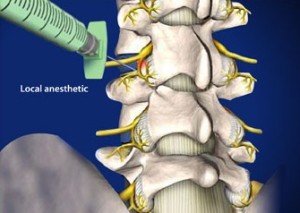Table of Contents
Lumbar facet joint nerve block
A lumbar facet joint block is an injection of local anesthetic into one or more of the small joints located along the side of each vertebra on both sides of the spine in the lower part of the back. Multiple injections may be performed, depending on how many joints are involved.
It is often used as a diagnostic tool to confirm whether or not the facet joint is the source of a patient's pain.
During the procedure, the patient is typically positioned face down on a table, and the skin over the injection site is cleaned and numbed with a local anesthetic. The doctor then uses fluoroscopy (real-time X-ray imaging) to guide a needle into the facet joint.
Once the needle is in place, a small amount of medication is injected into the joint, which may include a local anesthetic to provide immediate pain relief and a steroid to reduce inflammation and provide longer-lasting relief.
After the injection, the patient may be monitored for a short period of time and then discharged home with instructions to rest and avoid strenuous activity for a few days. The effects of the injection may last several weeks to several months, depending on the individual patient's response.
While lumbar facet joint blocks are generally considered safe, there is a small risk of complications, such as infection, bleeding, or nerve damage. Patients should discuss the risks and benefits of the procedure with their doctor before undergoing the injection.
Lumbar facet joints have been implicated as the source of chronic lumbar pain in 15% to 45% of patients with chronic low back pain.
Objective: The study was conducted to determine the clinical effectiveness of therapeutic local anesthetic lumbar facet joint nerve blocks with or without steroid in managing chronic function-limiting low back pain of facet joint origin.
Design: A randomized, double-blind, controlled trial.
Setting: An interventional pain management setting in the United States.
Methods: This study included 60 patients in Group I with local anesthetic and 60 patients in Group II with local anesthetic and steroid. The inclusion criteria was based on the positive response to the diagnostic controlled comparative local anesthetic lumbar facet joint blocks.
Outcome measures: Numeric pain scores, Oswestry Disability Index, opioid intake, and work status. All outcome assessments were performed at baseline, 3 months, 6 months, and 12 months.
Results: Significant improvement with significant pain relief (> 50%) and functional improvement (> 40%) were observed in 82% and 85% in Group I, with significant pain relief in over 82% of the patients and improvement in functional status in 78% of the patients. Based on the results of the present study, it appears that patients may experience significant pain relief 44 to 45 weeks of 1 year, requiring approximately 3 to 4 treatments with an average relief of 15 weeks per episode of treatment.
Conclusion: Therapeutic lumbar facet joint nerve blocks, with or without steroid, may provide a management option for chronic function-limiting low back pain of facet joint origin 1).
Studies report variable pain relief in response to diagnostic blocks of the medial branch nerves (MBN) which innervate facet joints indicating that these can be a source of low back pain. A variable number of low back pain (LBP) sufferers report clinically significant pain relief in response to medial branch blocks (MBBs) 2) 3) 4).
Facet blocks with anesthetic and cortisone, and even facet denervation procedures, have been recommended as treatment for patients with low back pain (LBP). The literature, however, fails to conclusively document the role of the facet in the production of LBP. Based on a review of the literature and the author's clinical studies, the following statements appear to be appropriate and defensible:
(1) The lumbar facet joints are very important biomechanically.
(2) The facet is not a common or clear source of significant pain.
(3) The facet joint syndrome is not a reliable clinical diagnosis.
(4) Injection of intraarticular saline into the facets in control cases is as effective as local anesthetic and steroids in relieving the patient's pain temporarily.
(5) Response to facet joint injection in patients with LBP does not correlate with or predict their clinical results after solid posterior lumbar fusion, and it should not be used preoperatively as a clinical criterion in selection of patients for fusion.
(6) More prospective, controlled and randomized clinical studies are recommended 5).
There is evidence that suggests that facet joint injections can be used to predict outcome after facet joint radiofrecuency. The predictive ability of facet joint injections does not appear to apply to lumbar fusion surgery. No evidence exists to support the effectiveness of facet injections in the treatment of patients with chronic low back pain. There is conflicting evidence suggesting that the use can be effective for the short-term relief of low-back pain. There are no data to suggest that with either steroids or anesthetics alone provide lasting benefit for patients suffering from chronic low-back pain 6).
Studies report variable pain relief in response to diagnostic blocks of the medial branch nerves (MBN) which innervate facet joints indicating that these can be a source of low back pain. A variable number of LBP sufferers report clinically significant pain relief in response to medial branch blocks (MBBs) 7) 8) 9).
